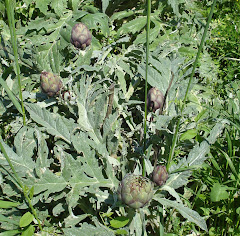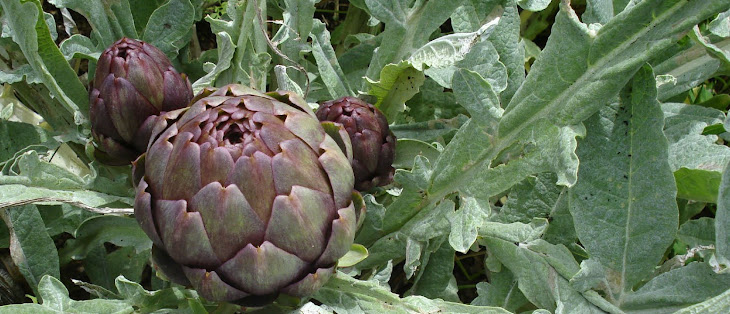One of the saffron fields at Les Roches Rouges where we went to visit the Safran de Neffiès project started by a group of enthusiasts in Neffiès, including the owners of the village bar:
and the view back towards the village from the hillside on an unusually misty morning:
It takes 150 Crocus Sativus Linnaeus flowers to produce 1 gram of saffron, so that’s why it costs 500 euros, or more, per kilo. The petals are then carefully removed from around the pistils. You can see pictures of this here. Most of the flowers had already been picked but the growers had left a couple of rows so that we could see them and help pick them. A group of a hundred interested people had walked from Neffiès to see the fields and have lunch.
 |  |  |
The red pistils that can be seen in the centre photo above are the important, saffron, part of the flower, although the whole flower is edible.
 |  |  |
After visiting the fields we walked up among vineyards and olive groves to a field higher up, bordered by evergreen Holm oaks, where long tables decorated with crocus flowers were laid out in the shade for our meal of paella made with this local saffron followed by a dessert made of choux pastry filled with saffron cream.
 |  |
We were lucky that it was warm and sunny, and it was a beautiful place to eat a delicious lunch, served with excellent Neffiès wine, of course.
One tip from the leaflet about Les Roches Rouges is that saffron should be soaked to release its flavour in warm water, milk or wine for 4 hours at least – I hadn’t realised before that it should be soaked for so long.
Saffron in Afghanistan
I noticed this video on the Guardian website which shows how saffron growing is replacing poppies in one part of Afghanistan.











8 comments:
Wonderful. I have read a few articles on saffron now. What a magical herb and culture.
I once bought 100g of saffron on a market in Jordan for a laughably cheap price (about £5 or so). It may not have had such an intense flavour, but you didn't mind using great pinches of it as it was so cheap.
We have saffron patches here too in Central Otago. But it is more often in small patches like a vegetable garden. Kerry Hand www.thefieldofgold.blogsot.com
It sounds like a wonderful day out, and the lunch sounds delicious!
This post was very interesting.Lovely photos and a lovely story to go with them.Thanks for sharing with me.
I hope you don't mind answering my question - how long does saffron stay fresh?
@Olga: once they're dried, the saffron threads will keep for months in an airtight jar... even years perhaps, although the flavour would fade with time.
Hi Chaiselongue !
Thanks for stopping by my blog & commenting too.I'm your newest follower.You'd be very welcome in my blog.Actually, I'd be delighted !
LOVELY. Wouldn't it be wonderful IF saffron could replace opium?
I grow saffron crocus in pots, but this year they were a flop. Don't know if it was bad weather or...?
Love your postings,
Sharon Lovejoy Writes from Sunflower House and a Little Green Island
Post a Comment